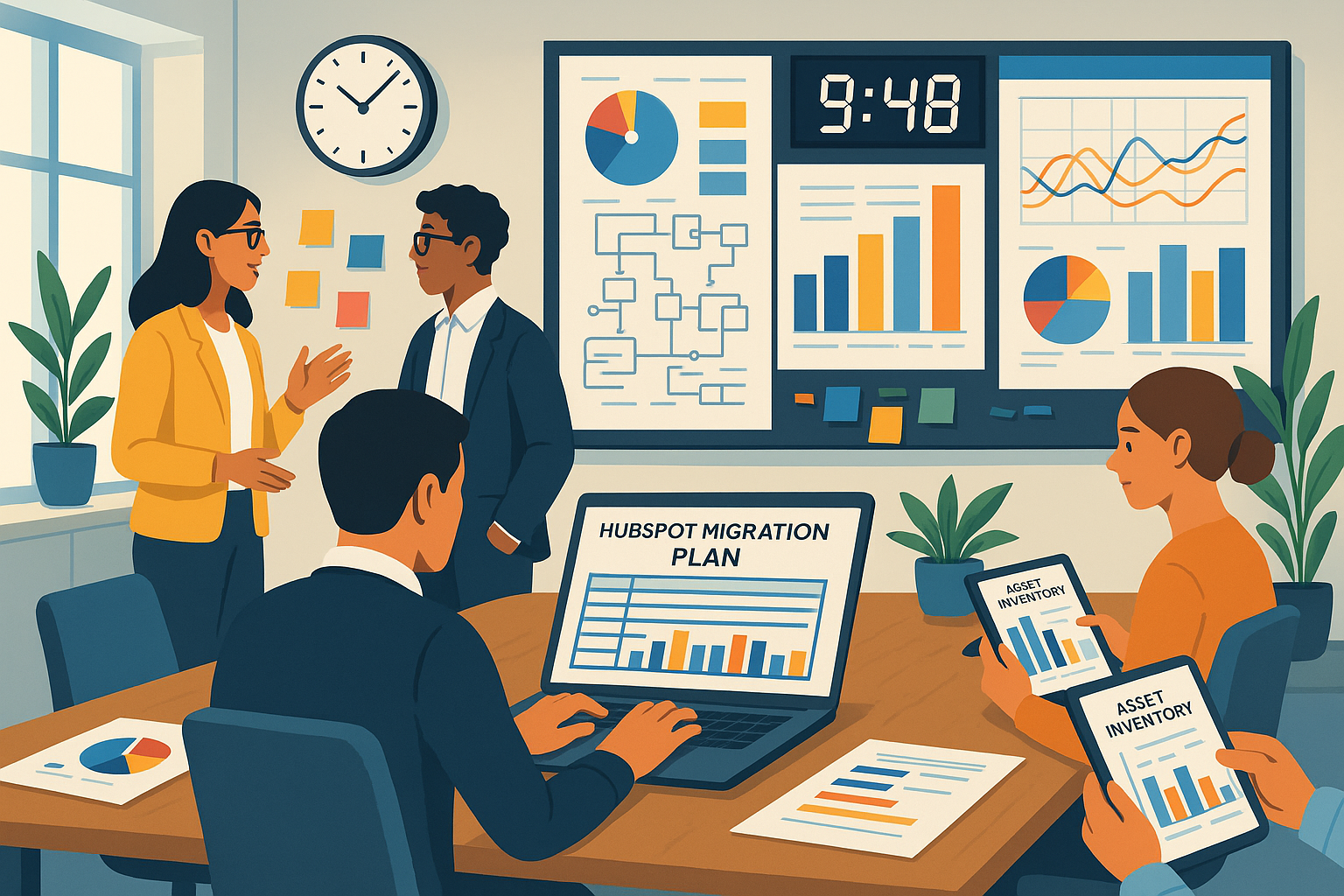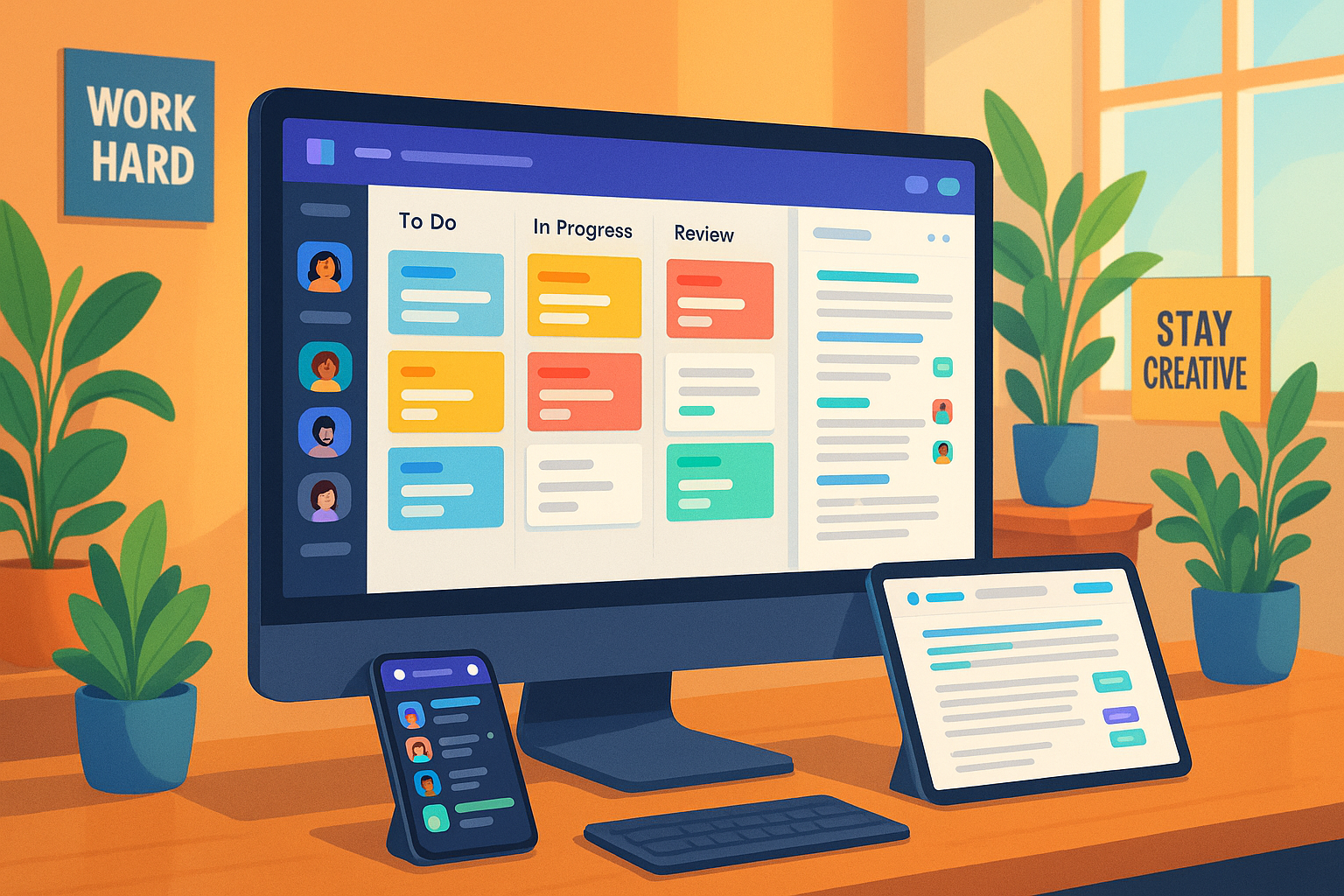What is enterprise application integration (EAI)?
Enterprise application integration (EAI) refers to the process of linking an organization's various business applications, services, databases, and systems into a unified framework that promotes communication and cooperation between them. Data can be shared seamlessly through an EAI platform while automating workflows and business operations. This ensures data consistency across the organization, with any changes made in one system being accurately reflected in others.
The EAI platform acts like middleware, connecting different systems without the need for reprogramming or significant modifications. It uses technologies like message-oriented middleware (MOM), service-oriented architecture (SOA), enterprise service buses (ESB), or application programming interfaces (APIs) to enable system interoperability.
An EAI platform is versatile enough to integrate various on-premise and cloud-based services. It can be used in systems like accounting, billing, CRM, HCM, SCM, and ERP. The platform’s adaptability makes it simple to add, remove, or update applications or services without disrupting operations or requiring a major redesign of the systems in place.
Why is enterprise application integration essential?
Enterprise application integration (EAI) is crucial because most organizations depend on a variety of applications and services for their daily operations. These systems often have distinct data stores, unique processes, and different ways of communicating. This lack of integration can lead to the formation of data silos, where data is duplicated, inconsistent, or only accessible by certain systems.
Data silos can cause several problems. For instance, users might need to manually transfer data between applications to complete a task, or they may have to access multiple systems to perform their daily activities. Additionally, data analysts often face challenges with incomplete, inconsistent, or inaccurate data, making it difficult to answer key business questions or make informed, data-driven decisions.
An EAI platform provides the necessary tools and capabilities to allow these applications and services to share their data and workflows. This integration can help reduce manual tasks, minimize data errors, and offer better insights into the organization's overall data, improving decision-making and operational efficiency.
What are the key features of enterprise application integration platforms?
Enterprise application integration (EAI) platforms are essential for enhancing communication and ensuring systems work together smoothly within a business. When evaluating an EAI platform, look for these key features:
- Strong Connectivity: A reliable EAI platform should enhance the organization’s connectivity by linking all databases, systems, and applications. It should support multiple communication protocols, interfaces, and data formats to enable seamless interaction between different systems.
- Data Transformation: The platform should be able to convert data from one format to another, ensuring a standardized format is used across all integrated systems. This helps improve compatibility and ensures consistent information sharing between diverse applications.
- Message Brokering: EAI platforms should facilitate real-time communication by acting as message brokers. They manage message routing, transformation, and delivery between systems, supporting event-driven architecture to ensure timely information exchange.
- Automation: The platform should be capable of automating and orchestrating workflows across multiple applications. By coordinating tasks and processes, it streamlines business operations, ensuring tasks are executed efficiently and consistently across the organization.
- Monitoring and Management: An effective EAI platform must include monitoring tools to track system performance, health, and status. Features like dashboards and reports help identify issues early, maintain system functionality, and optimize the overall integration environment.
- Scalability and Extensibility: The platform should be able to scale with the organization’s growth, accommodating increases in data volume, transaction rates, and new applications without compromising performance. It should also be flexible and adaptable to evolving business needs and changes in the integration process.
Best Practices for Enterprise Integration
Successfully implementing enterprise integration becomes more manageable by following certain best practices:
Begin with a platform-based approach
Using a platform-based strategy allows for comprehensive enterprise connectivity, addressing various integration needs such as applications, processes, data, usage, and sensors. This works across on-premises, cloud, and hybrid environments, ensuring flexibility and adaptability.
Leverage APIs as core components
APIs act as versatile building blocks within the integration platform, facilitating the connection of people, processes, and systems. This enables the business to adapt its digital assets into new business models, exploring different monetization strategies with ease.
Make integration accessible to everyone
By democratizing the integration process, businesses can empower all users to build and update integrations without needing coding skills. This lowers the reliance on specialized developers and maximizes business value by allowing users of all technical levels to contribute.
Apply smart lifecycle management
Establish ongoing management strategies to sustain the enterprise integration framework. These plans should cover access control, change management, integration expansion guidelines, system credentials handling, and data encryption. For hybrid setups, lifecycle management must accommodate deploying patches and updates to both on-premises and cloud-based systems.
Enhance with analytics and predictive intelligence
Analyze integration activities to gain insights from data flows across the business, departments, and systems. As user-driven integration grows, predictive intelligence can identify integration trends and patterns, further improving operations.
Create an integration center of excellence (ICoE)
An integration center of excellence (ICoE), or integration competency center (ICC), functions as a centralized unit that systematically integrates data, systems, cloud platforms, and applications. This approach is scalable, cost-effective, and provides a lasting competitive edge. The ICoE standardizes processes, shares knowledge across the organization, and helps lower costs, stabilize supply chains, foster growth, enhance decision-making through smart technologies and predictive analytics, and automate smarter processes.
These features will ensure your EAI platform supports the organization’s needs, enhances system interoperability, and keeps your IT environment aligned with business objectives.
10 Best Enterprise Application Integration Platforms
1. SyncMatters
SyncMatters is an integration platform as a service (iPaaS) designed for integrating, transferring, and managing data within CRM systems. It supports over 45 different systems, allowing you to move and transform data, adjust formats, and more. As a leading data integration solution, SyncMatters ensures smooth data flow between platforms, improving operational efficiency and data accuracy.
Key Features:
- Integration for 45+ systems: Includes popular systems like HubSpot, Salesforce, Quickbooks, Sage 100, and Microsoft Dynamics 365.
- Automapping and Custom Object Creation: Streamlines the integration process and reduces manual mapping work.
- Data Filtering and Advanced Mapping: Offers flexibility for managing complex data scenarios.
- One-Time and Repeated Migrations: Accommodates both project-based and ongoing integration needs.
- B2B Focus: Provides tailored solutions for CRM partners and agencies.
2. Azure Integration Services

Azure Integration Services, developed by Microsoft, is a suite of tools for application integrations. It offers a serverless environment that streamlines the connection of apps, systems, and data with over 600 pre-built connectors and services like Azure API Management, Logic Apps, Service Bus, and Event Grid. The platform enables secure integration, automation of business processes, and scalable app development, with built-in security and flexible pay-as-you-go pricing.
Key Features:
- Logic Apps: Set up workflows to integrate cloud and on-premises services.
- Service Bus: Securely connect cloud and on-premises apps to messaging workflows.
- API Management: Create and publish APIs for both internal and external use.
- Event Grid: Managed event routing makes event-based software development easier.
- Azure Functions: Use event-driven processes to solve complicated orchestration concerns.
- Azure Data Factory: Visually integrate data sources to generate ETL and ELT processes, which accelerates data transformation operations.
3. Boomi

Boomi is a software company specializing in Integration Platforms-as-a-Service (iPaaS), API management, and data solutions. Founded in 2007, Boomi helps organizations streamline data integration with pre-built connectors that simplify data exchange across cloud, on-premises, and edge environments. Its "Suggest" feature uses machine learning to simplify data mapping, while the self-updating platform ensures smooth operation without manual oversight. Boomi also offers regression-tested integrations and crowdsourced troubleshooting, maintaining 99.99% uptime even during network issues.
Key Features:
- AI Integration: Speeds up processes with built-in intelligence.
- Reusability: Components that automate and scale easily.
- User-Friendly: Supports role-based access and collaborative development.
- Scalability & Security: Elastic scaling and enterprise-grade security.
- Lifecycle Management: Built-in governance for workflows and data models.
4. Workato

Workato is an advanced integration and workflow automation technology that helps businesses optimize their operations. It provides a low-code/no-code environment in which IT and business teams may automate tasks and integrate apps, data, and workflows. Workato's cloud-native design and simple drag-and-drop interface make it easier to construct APIs and integrations, saving time and money on development. The platform has a large library of connectors and automation recipes, as well as enterprise-level functionality such as scaling, governance, and error management.
Key Features:
- Recipe Design: Customize automation recipes with various triggers and actions.
- On-prem Connectivity: Secure connections from private IT environments to Workato’s cloud.
- API Platform: Convert API recipes into endpoints for easy data sharing.
- Workbot: Build and customize workflows.
5. MuleSoft

MuleSoft's Anypoint Platform is a robust integration platform built to connect programs, data, and devices across different environments. It provides API management, data integration, and application connectivity capabilities that are compatible with both cloud and on-premises implementations. The platform includes a large number of pre-built connectors and enables smooth API construction, implementation, and monitoring.
Key Features:
- Anypoint API Designer: A collection of APIs, templates, examples, and connectors to facilitate API creation.
- Anypoint Studio: An integrated development environment (IDE) for building integrations and APIs.
- Anypoint Connectors: Tools for system integration, available through both a web interface and a desktop IDE.
- Anypoint Exchange: A marketplace offering connectors, templates, examples, and APIs for easy access.
- Anypoint DataGraph: A tool for reusing, consuming, and unifying multiple APIs.
- Anypoint Partner Manager: Speeds up the onboarding process for partners and streamlines partner management.
- Anypoint MQ: A messaging service designed for asynchronous communication patterns.
- Anypoint Code Builder: An IDE for designing, developing, and deploying APIs, integrations, and automations.
6. IBM

IBM App Connect Enterprise is a top integration platform from IBM that ensures smooth information flow between various applications and platforms, whether on-premises or in the cloud, including AWS. It allows organizations to quickly connect SaaS applications and build workflows using pre-built connectors and customizable templates.
Key Features:
- Versatile Deployment: Works on-premises and across cloud platforms like AWS.
- Pre-Built Connectors and Templates: Quickly connect SaaS applications and design workflows.
- No-Code Interface: User-friendly design with AI-based features for various skill levels.
- App Connect Designer: Drag-and-drop system for easy integration creation.
- Developer Toolkit: Supports complex integrations with various programming languages and management tools.
- App Connect Dashboard: Offers observability, health checks, and troubleshooting for data and application security.
7. Informatica

Informatica specializes in cloud data management and integration, offering the AI-powered Informatica Intelligent Data Management Cloud (IDMC). Its platform supports seamless API and application integration, real-time data orchestration, and intelligent hyper-automation across multi-cloud and hybrid systems. Informatica automates processes and enhances governance by providing a codeless, user-friendly interface, pre-built connectors, and unified tools for integration, API creation, and event management. Informatica is trusted by users in over 100 countries, including 85 of the Fortune 100. It drives efficient business processes and data unification around the world.
Key Features:
- API and Application Integration: Enables intelligent hyperautomation and real-time integration with industry-leading iPaaS capabilities.
- Pre-Built Connectivity: Offers out-of-the-box connectors for seamless data integration and management.
- Codeless Integration: Provides a user-friendly, no-code interface for API and application integration, reducing the need for complex coding.
- Intelligent Business Process Automation: Empowers teams to automate processes efficiently and optimize workflows.
8. Oracle Cloud Infrastructure

Oracle Cloud Infrastructure (OCI) is a cloud computing service by Oracle that provides on-demand access to servers, storage, networking, and applications via its global data centers. OCI integrates various applications and data sources like Salesforce, SAP, Shopify, Snowflake, and Workday, automating workflows and centralizing management. It offers prebuilt adapters and low-code tools to simplify cloud migration and streamline operations across hybrid and multi-cloud environments.
Key Features:
- Global Cloud Infrastructure: On-demand access to servers, storage, and networking through Oracle's data centers.
- Prebuilt Integrations: Connects apps like Salesforce, SAP, and Workday, automating processes with low-code customization.
- Process Automation: Unifies workflows across ERP, HCM, and CX systems using templates and visual design tools.
- API Lifecycle Management: Tools to design, build, secure, and manage APIs.
- Event Streaming: Kafka-compatible serverless event streaming with prebuilt integrations for big data pipelines.
9. TIBCO

TIBCO Cloud Integration, part of Cloud Software Group, is an iPaaS that accelerates application and data integration across hybrid environments. It is based on the open-source Project Flogo and supports both API-led and traditional integration methodologies, which reduces costs and accelerates time-to-market. The platform's graphical interface, powered by TIBCO Scribe, and pre-built connectors make it easy to integrate cloud and on-premise applications. With its API automation and no-code app development through TIBCO Cloud Live Apps, even non-technical users can build and automate enterprise-grade solutions.
Key Features:
- Hybrid Integration Support: Connect applications and data across hybrid environments using different integration styles.
- Open-Source Framework: Built on Project Flogo for flexible and efficient integration.
- API Automation: Automate and embed functionality with a shared API across user interfaces and command lines.
- No-Code App Development: TIBCO Cloud Live Apps enables non-technical users to create enterprise applications without coding.
10. Zapier

Zapier is an automation platform that helps users integrate different web apps and automate workflows, ensuring data stays updated across an organization. With over 6,000 integrations, Zapier simplifies app connections for better collaboration and data accuracy. Its advanced control options allow users to manage errors and limits, preventing data loss. Zapier emphasizes security with SOC 2 compliance, SAML single sign-on (SSO), and detailed app permissions. It offers support through live chat, automation strategy calls, and self-guided content like videos and pre-made workflows, empowering businesses to confidently streamline their processes.
Key Features:
- Extensive Integrations: Supports over 6,000 app integrations for seamless automation.
- Granular Controls: Offers customizable error handling and response options to prevent data loss.
- SOC 2 Compliance: Enforces stringent security standards, including data protection and privacy.
- Advanced Admin Controls: Includes features like SAML single sign-on (SSO) and app permissions for enhanced security.
- User Support: Provides live chat, automation strategy calls, and zap-building insights for comprehensive user assistance.
- Self-Guided Learning: Offers extensive resources, including videos, blog posts, and pre-made workflows for independent learning.
Why should you use an enterprise application integration platform?
Using an enterprise application integration (EAI) platform helps reduce the chances of data duplication and ensures that information remains consistent across applications, which lowers the likelihood of errors and potential risks. Organizations that adopt EAI platforms experience greater operational efficiency, improved flexibility, and a more unified IT system. Some specific advantages include:
- Removing data silos
- Improving customer satisfaction
- Reducing costs
- Enabling real-time decision-making
- Adapting to emerging technologies
- Simplifying business processes
- Supporting mergers and acquisitions
In general, EAI platforms help organizations tackle issues related to data integration, system interoperability, and connectivity. By embracing these platforms, businesses create a more agile, efficient, and responsive IT environment that better aligns with their overall goals.
.png)







